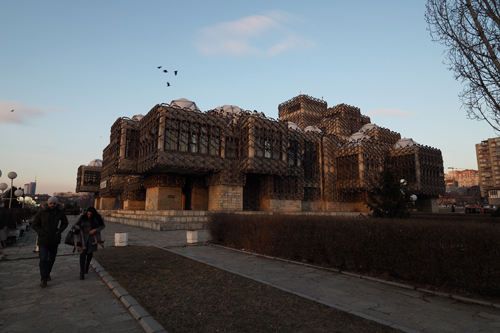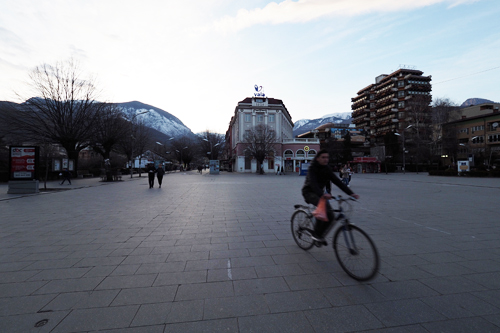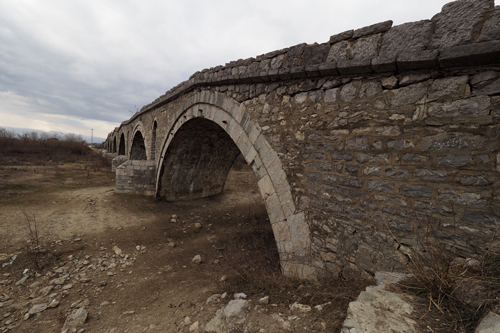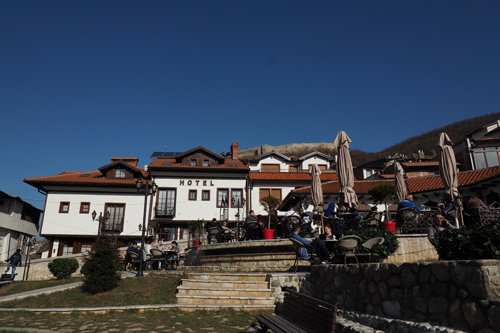February 24, 2019. Skopje, Macedonia to Priština, Kosovo.
All the family went to the airport for flights to various destinations and we were there to pick up our drive to Priština, in Kosovo.
Hayden and Andrea were heading back to Berlin. While Steph was extending her time away with a trip to France. This was to see her friends from the days of her exchange there. Ev was returning to New York – work called.
All didn’t go according to plan as Ev’s flight to NYC, via Istanbul, was cancelled due to bad weather in Turkey.
As it turned out he got an extra 24 hours in Skopje, courtesy of Turkish Airlines.
Gligor was again on hand and organised Iran to drive us from Skopje to Priština.
It was an uneventful 98 km where we didn’t even have to get out of the car to do the border crossings.
This was fine with us as it was about -5°C outside.
This next part of the trip had been organised though KimKim, a US based tour company that uses locals to organise everything.
They provide an itinerary, hotels and a hire car, which is delivered to your hotel.
The car, a white Opel Corsa, was from Albania and two guys from the rental company had driven it to Priština from Tirana.
They also gave us a very low tech local mobile for emergencies and a TomTom GPS.
Now we have two.
The phone might prove to be useful as we had no mobile coverage in Kosovo. The GPS was useless as the maps didn’t correspond to where we were travelling.
Needing to stretch our legs after the drive we went for a walk through the commercial area of Priština.
Priština is the capital of Kosovo with a predominately Albanian speaking population. In fact we were told that 90% of the entire population of Kosovo are Albanians.
Over the centuries the area of the present day Kosovo has been occupied by many races.
During the Classical Period it was the Celtics and Romans. In the Middle Ages it was inhabited by the Byzantine, Bulgarian and Serbian Empires. And from the 15th to 20th centuries it was part of the Ottoman Empire.
To many, modern Kosovo doesn’t exist, as it’s not recognised by many international governments. Only 112 of the 193 UN member states see it as a real country.
There is an ongoing territorial dispute between The Republic of Serbia and the self proclaimed Republic of Kosovo. It is not a formal member of the Eurozone but it does use the Euro as its currency.
After dinner we got chatting to the receptionist at our hotel, Pritzen. He was interested in why we were in Kosovo and where we had been.
When we told him we had just spent a week in Macedonia he was amused, describing Skopje as ‘Disneyland’.
I had to agree with him.
February 25, 2019. Priština, Kosovo.
After a sleep in and a late breakfast we ventured out onto the roads around Priština.
Driving in Macedonia had been a hairy experience and it looked like Kosovo might be similar.
The Corsa was rather low-tech and underpowered but you wouldn’t want to drive quickly anyway.
Our main destination was the Gračanica Monastery. It was established in 1321 by the Serbian King Stefan.
The main church interior was beautifully decorated by frescos, but unfortunately no photos were allowed.
This was also the case in the Macedonian monasteries and churches that we visited.
It does leave a gap in the snaps.
After that we drove to Gračanica Lake, an artificial reservoir built in 1963-1966 to supply drinking water to Priština.
It was a rather boring view so we then just continued back into town.
In the afternoon we went on foot to explore Priština, following the same path that we had taken the previous evening. This time we had our cameras and much more time.
The main contemporary feature of the city is the Mother Teresa Boulevard. It is a very wide walking strip that has numerous bars, cafes and upmarket shops on either side.
We went to the top of the bell tower of the Mother Teresa Cathedral.
Fortunately there was a lift.
I don’t think my knees could have handled the climb in the sub zero temperature.
We continued on to the Peter Bogdani Library, the National Library of Kosovo. Designed by the Croatian architect Andrija Mutnjaković and inaugurated in 1982 it is regarded by some as the ugliest building in the world.
It has very unusual architectural that is supposedly a blend Byzantine and Islamic styles. The many domes are said to represent Turkish bathes.
February 26, 2019. Priština to Pejë (Pec), Kosovo.
The Balkan’s seems to be a society dominated by men.
On the street men walk in groups talking and smoking.
Many of the cafes seem to be a male domain. In there they sit, talk and of course smoke.
On our first morning in Priština we went to a cafe that was next door to our hotel.
It was a ‘man cave’.
Young and old men deep in conversation who glanced at Thea with a sense of disapproval.
And again all were smoking.
On our second and last morning we found ‘iCafe’. It was slightly less a man’s world as there were a couple of women there.
But again they were smoking.
Yes there are equally as many women around but they don’t dominate the space like the men seem to do.
On our afternoon walk down Mother Teresa Boulevard we did manage to find ‘Half and Half’ a very funky cafe with great art and atmosphere.
I now wonder if the half and half was referring to the gender balance.
After we left the hotel we drove south to Gadime. This was to explore the marble caves that were discovered there in 1969.
This labyrinth is over 80 million years in the making and extends 5 kilometres into the mountain side.
At our deepest point we were 250 metres beneath the surface.
What makes them unique is that they are carved out of pure white marble.
What would their state be now if the Greek or Roman empires had discovered this treasure trove of building material?
Decimated I guess.
The big challenge for the day was finding our hotel in Pejë.
Getting into this small town, at the foot of the Gjeravica Mountains, wasn’t difficult, working out where the hotel and then the car park was.
After half an hour of driving around in circles and then 15 minutes of Thea exploring the area we finally found the entrance.
We were the guided, by a Gollum like person, into the underground maze of parking spaces.
Late in the day, after checking into the Semitronix Hotel, we went for a walk around Pejë.
The snow capped mountains, behind the village, dominate the landscape.
This area seems to be predominantly Muslin as cafes, not bars, are everywhere in the shopping areas.
Once the sun had set, which was at 5:15, we returned to our hotel.
Another enjoyable, yet in the end, frustrating day.
February 27, 2019. Pejë (Pec) to Prizren, Kosovo.
It’s strange that in a country that is very Muslim we have visited nothing but monasteries.
This region was under the control of the Ottoman Empire for 500 years and their influence is everywhere.
In an attempt to right this wrong we planed to visit our first mosque – that didn’t happen. The directions to the Mosque of Hadum in Gjakovë were so vague, we never found it.
It was therefore back to churches and monasteries.
The Serbian Orthodox Monastery of Pec was built in 13th century in the Serbo-Byzantine style. It was restored during 2006 and is part of the Medieval Monuments of Kosovo and is also a UNESCO World Heritage Site.
The complex consisted of several churches, the Church of the Holy Apostles, Church of St. Demetrius, Church of the Holy Mother of God Hodegetria and the Church of St. Nicholas.
The next stop was at Visoki Dečani, another Serbian Orthodox monastery which was also part of the Medieval Monuments of Kosovo and again a UNESCO World Heritage Site.
It was designed by a Franciscan friar, Fra Vita, with construction starting in 1327, during the reign of the Serbian King Stefan Dećanski.
In 1331 Dećanski’s son, Stefan Duśan, seized the throne from his father, who he then had strangled to death and dumped in a forrest.
Very Game of Thrones.
Twenty nine kilometres north of Prizren we did discover the Ura e Terzive, an Ottoman bridge over the Erenuku River.
Believed to have been initially built at the end of the 15th century and then expanded in the 18th century, it’s an important example of Ottoman bridge building.
It consists of 11 rounded arches, spanning 190 meters and is 3.5 metres high.
It was rather rewarding to eventually see something from the Ottoman era.
Once we reached Prizren again a lot of time was spent trying to find our hotel and the associated parking.
This ended in disaster.
I was turning left, in what I thought was a two way street, and was collected by a car overtaking me at speed on my left.
He glanced the side of the Corsa knocking the front mudguard out of place.
The Tourist Police, who were nearby, told me to just wait there as the Traffic Police would soon arrive to get all the details.
This was a minor accident and my car was sitting in the middle of the road, so I moved it to the side, as I would have done in Australia – wrong.
The Traffic Policemen, there were two of them, soon arrived and started to interrogate all involved, except me, as no one spoke English.
We used our local mobile and phoned Xheni, our Albanian contact at KimKim. She told us to just wait and then get an accident report from the police.
After the cops had done their thing at the scene of the ancient, I was told to follow them to the police station. By this time they had taken my driving licence and I was getting a little nervous.
The guy in the other vehicle had to go in the police car to the station, as his vehicle was un-drivable. He had been travelling so fast, that after glancing me he had careered off the road and into a tree.
Thea opted to stay in our car while I went into the cop shop, thinking proceedings wouldn’t take that long.
Again, wrong.
After an hour and a half she decided to come into the stations it was dark and getting very cold.
One of the policemen interrogated me with very little English and asked me to write a statement. I then found out that I had caused a real problem by moving my car off the road.
This is unacceptable, as the traffic police can’t then determine how the accident occurred.
The second policeman was interviewing the driver in another room.
It was eventually decided that I was in the wrong and I was issued with a €180 fine. I was told that If I payed the fine now it would be reduced to half that amount, €90.
I had a feeling that I was being set up, until I was told I had to go tho the Post Office to pay the fine and they would drive me there.
Fortunately we had cash, as the banks were closed. I was then rushed to the Post Office, before it too closed, to ‘officially’ deposit the €90.
By this time the two police officers, No: 8738 and No: 4280 were my newest best friends. Even the guy in the other car came out of the interrogation room and apologised for smashing into me.
It was not an experience I would like to repeat but, as it turned out, it was as good as could be expected.
And all in a day’s work when you are tourist.
February 28, 2019. Prizren, Kosovo.
Our room in the Hotel Prizren was one of the strangest we have experienced.
It had everything you’d expect except the shower was in the room, at the end of the bed.
It was a tardis-like glass box, next to the wash basin, and had a motion control for the exhaust fan and light.
The problem with that was a soon as you stopped moving everything turned off.
The Ottomans invaded Kosovo in 1454 and in June 1455 Prizren surrendered to the Ottoman army.
The area is decidedly Muslim, with around 40 mosques in the town.
There was one right next to our hotel and the first call to payer was at 4:30am.
I know, it woke me up.
There is a real cacophony of sounds when all the imams start to chant at the same time.
And they do it five times a day.
Part of the Ottoman legacy is the Old Stone Bridge of Prizren, as it is known, which is over the Bistrica River. Built in the 16th century, it’s an important pathway between the two sides of the old city.
The hill, where Prizren Fortress now sits was first settled around 1,100 BC and the fortifications were built between the 11th and 15th centuries.
Prizren Castle has been under the control of the Byzantine, Serbian and Ottoman Empires and has a rich history.
For a period Prizren was the first Serbian imperial capital and was called City of the Emperor or Serbian Tsarigrad.
The Ottomans enlarged the fortress and held it until 1912 when it fell to the Serbians in the First Balkan War.
On the steep walk down from the castle we met two young men. They were stopped having a smoke.
One got chatting to us in a very Yanky accent, which he had picked up from watching American TV networks and YouTube videos.
We got to discussing the benefits of Kosovo becoming a member of the EU or Schengen. He wasn’t convinced the EU was best for the country but believed that joining Schengen was certainly better for him.
Why? Well there were more Schengen countries for him to move to and look for work.
After visiting the fort we wandered back into the old town, near our hotel, and just wandered.
Firstly we discovered that the Sinan Pasha Mosque, which is right beneath our hotel, has Cafe Konaku within the mosque grounds.
It was crowded, not just with men smoking and drinking coffee, but with family groups and lots of young people.
There was also a small bazaar next to the cafe. There was certainly a lot of enterprise surrounding the mosque.
Then I found craft beer.
Sabaja Craft Brewery only had one beer on tap but another two bottled brews. However the draught was far better than the local pilsner that was on offer everywhere else.
In 2012 Sabaja was Kosovo’s first brewery to go outside the pilsner box and now produces a range of craft beers, designed to challenge the local’s taste buds.
Because winter is the slow time for tourists the bars normally don’t put on draught beer. However that evening we did discover Besimi, a Turkish style family restaurant that was rather busy.
Busy enough to have beer from the barrel that is.
Unfortunately it was a pilsner.
March 1, 2019. Prizren, Kosovo.
On the previous day’s walk around Prizren we had purchased some strong vinyl adhesive tape. This was to repair the car after the prang.
With the help of Toia, the receptionist at the hotel, we managed to reattach the dislodged front mudguard and make it all secure.
We then drove above the snow line, into the Shar Mountains, to the east of Prizren. The scenery was spectacular and it was a good opportunity to test the patched up Corsa. Firstly to see if the tape would hold and more importantly to see that there was no serious damage done to the car as a result of the accident.
The round trip was about 76 kilometres and then we returned to Prizren.
In the afternoon we visited some of the local sites, some Christian, some Ottoman.
In 1944 the German army was driven from Kosovo by a combined, Russian and Bulgarian force. Then the Communists took control.
In 1946 Prizren became part of the Autonomous Region of Kosovo and Metohija within the People’s Republic of Serbia, a state of the Federal People’s republic of Yugoslavia.
If you think we have a coffee culture in Melbourne, then you need to visit Prizren.
The old part of the city is lined with cafes, which are all full.
And this isn’t even the tourist season yet.
Everyone drinks coffee and sometimes tea and they drink it day and night.
When most of Melbourne has moved from caffeine, to something a little harder, the people of Prizren are still downing their espressos and macchiatos.
We visited the bar, where I discovered craft beer on the previous night. This time it was a bit later in the evening and, guess what, people we’re still drinking coffee.
Part of the reason is that this is a predominately Muslin country but it also has a lot to do with the fact that they just love their coffee.














